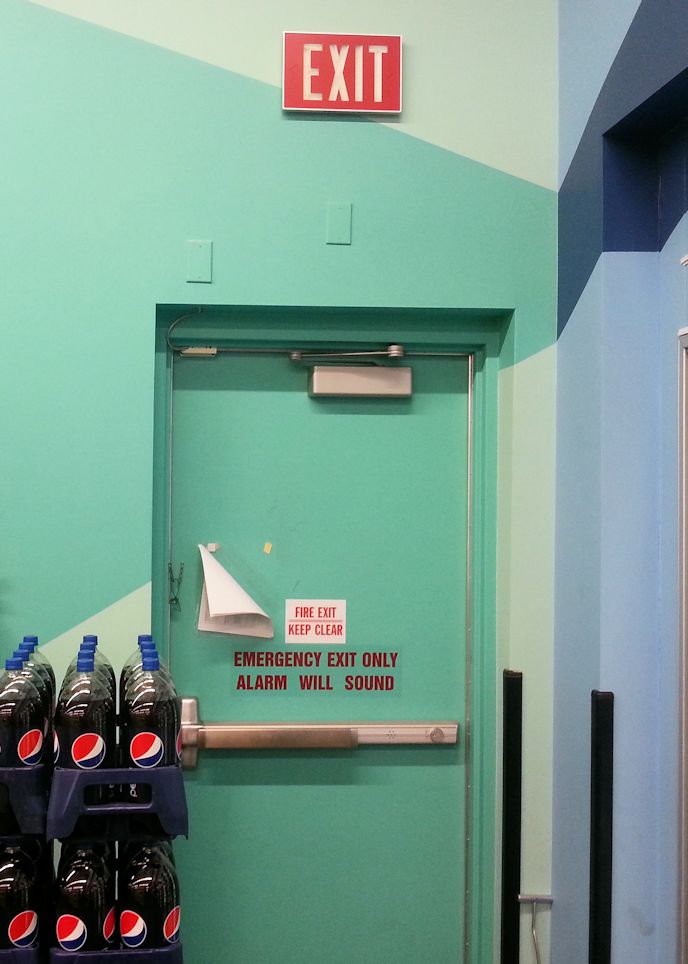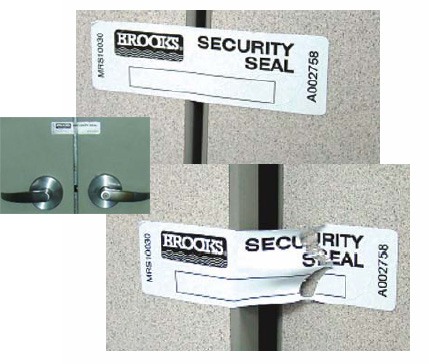Have you ever seen an egress door with a tamper-resistant tag on it? I saw one on a department store stair door in New York City last year, and Wayne Ficklin sent me these photos which got me thinking about this application again. Would you consider these acceptable for use on an egress door? Why / why not?
I also found this Emergency Exit Seal and Sash by Unisto:
And these Fire Door Security Seals sold by HSA Security Seals:
Do you think one type is more code-compliant than another? What limitations, if any, would you impose on the use of these products? I’d love to hear your thoughts on the matter!
You need to login or register to bookmark/favorite this content.









I think that the weight needed to break a seal would be over the ada for egress? The paper tags may work, but a door contact or a camera would be the better solution.
I agree…one of the UK websites selling these products says that it breaks with less than 8kg force “in accordance with regulations.” I’d love to know if there are UK code requirements addressing this specifically, or if it would fall under the requirements for force to release the latch and set the door in motion. For accessibility, the limit would be 5 pounds for a non-rated interior door. For exterior doors and fire doors it would be 15 pounds to release the latch, 30 pounds to set the door in motion, and 15 pounds to open the door fully. 8kg is 17.6 pounds. Other products may have lower-force break points…I don’t think a lighter-weight loop would be less of a deterrent.
I don’t like the first one, with the sash-chain attachments to frame and door. Too easy to “upgrade” the breakaway connection to something that won’t break away.
The tear-away one, if it gives up with less than 5#, ok.
the sticker – no problem; but the leftover stickum might be a cleaning problem.
That’s a good point…someone could replace the breakable seal with a cable lock if they weren’t familiar with the code requirements.
To me, the guiding principle is all occupants MUST have free access out of a structure at all times the structure is open to occupants. Exit doors should invite use. There are appropriate forms of prevention of free access such as local egress alarms where exit hardware triggers them, delayed egress alarms and access controlled egress doors. Even in a building with doors locked, the means of egress if code compliant, will allow a person familiar with the building such as janitors, maintenance staff or workers in the building after normal hours to travel to an exit and either leave the building or find an area of relative safety (e.g. are horizontal exits often found in large hospitals).
I have seen people encounter impediments on exit doors, not expected, become confused about whether they can move through the door and turn back. In my opinion there should never be any sign, saw horse, tape, seal or anything that telegraphs the message that the exit is restricted to use and not available for free passage out. Visitors and clients who are unfamiliar with the property would have no concept of what was beyond the door and may decide to retrace their steps, maybe back into a growing fire problem
Egress doors should invite use in an emergency, not confuse users.
Jerry you have summed it up nicely!
“Egress doors should invite use in an emergency, not confuse users.”
Well stated.
I don’t think any of the examples above would work except for the paper tear seal…. The other methods may damage or void the manufacture’s Warranty of the door or the door hardware. Also ADA may play a lrge part in opening the door for the force required…… besides i am not sure if it qualifies for a single operation to open the door……..
I agree with Jerry. I also think that egress doors should not have any “Breakaway” type of physical impediments.
I’ve seen some doozies, including one exterior stairwell exit that had a clear glass jar over the doorknob.
The open-topped jar lid was screwed to the door much like a knob escutcheon, and the jar was screwed onto the lid with a dab of glue to keep it from being unscrewed. A glass-break hammer hung from a length of sash chain next to the door.
The use of security seals are only as good as the effort used to ensure the seal is intact with the last recorded serial number. We used these all the time when I worked as a correctional officer for the State of AZ. Every shift had to compare the serial number to the last number recorded in a log. Anytime the seal was broken an incident report was completed to document and explain the reason for breaking the seal. Though it was an inexpensive way to maintain integrity of a room with capital equipment or to an emergency key box, I think electronic door monitoring will be more effective especially when the area is accessible to people who are not familiar with the procedure and mistakenly breaks the seal. Chad – National Locksmithing Institute
I would think that egress doors should allow me to simply lean against the panic hardware in order to open them. And by lean, I mean without any momentum behind it. If I’m getting out of a building, I may be seriously injured and am simply trying to exit with a small amount of energy I might have at that time. The sticker above might break open in that instance, but I doubt that any of the others would easily give without a little bit of momentum behind a push. As designers, we should take into account that the occupants might be hurt or unable to move in a normal fashion.
I’m new enough that I’ve not seen or heard of many of these infractions – thanks for the continuing education!
the college I go to has fire exit doors that, either have an alarm and a push bar on it (you push the bar to open it) or an electromagnetic lock, with (green colour) emergency door release break glass unit and push bar.
Hi Lori,
Although these products are sold and available in the UK, we would NOT endorse the use of these. The GAI Guild of Architectural Ironmongers do NOT recommend either. Items like this can impede safe escape and can introduce additional delays in emergency circumstances. In addition using these can inhibit safety checks where the door is not opened and checked by occupiers. Although the force requirements within BS 8300 and information within BS EN 1125 differ from the American requirements The panic functions primary design is to offer safe escape and evacuation without prior knowledge of how to use. We assign 220N peak in the UK with BS 8300, way above ADA and NFPA.
A door contact and alarm and/or camera would be a lot more effective against unauthorized exit (such as theft or escape) than stickers. A sticker can’t alert a manager or guard that it’s been torn until that person sees it, which could be hours after the exit was used. And I agree heartily with the notion that confusing people in an emergency is dangerous and wrong.
I agree with most of the replies but I have a hard time accepting that anyone trying to escape (be it from fire, active shooter, etc.) is going to concern themselves with a sticker or a sign on a door.
I can understand both sides of the argument. We shouldn’t be impeding egress and that should go without question. However in the real world the security personnel do not want or have time to open and close each door several times a shift. Which would be necessary to verify a door is actually secure. Therefore an easily verified system like the paper seal will allow a visual walk by after a door has been closed and verified latched. If the tape is broken then the security personnel will know to take a closer look. I have experienced many openings over the years that have been tampered with to look latched and secure but were actually not. The seal depicts tampering. Cameras and other electronics are nice and work well most of the time but for many building owners or lessees just not practical financially initially or in a maintenance regime. Door contacts are easily defeated if you are on the non secure side of an opening. Cameras are expensive and rely on humans to be eyes on 100% of the time which again is too costly for many small and medium sized businesses. Perhaps the better solution is for the industry to take a leadership position and design a simple, reliable and inexpensive product that will secure doors like this eliminating the need for lockset, deadbolt, Detex Alarm and security bar all on the same door. The Arm A Door is close but would still need a “Tamper Evident” system.
Please quote the price for weak seal for emergency exit
Hi Amol –
I’m sorry – I don’t price or sell material.
– Lori